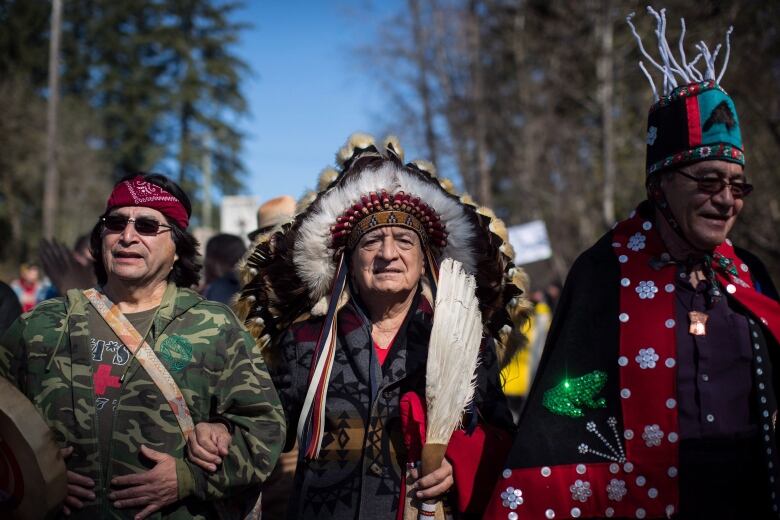Legal playing field tilted against First Nations in resource development battles, says new report
Corporations successful 76 per cent of the time when filing for injunctions against First Nations opposition

Canada'slegal landscape continues to be heavilyin favour of corporations when it comes to court injunctions during conflicts with First Nations over resource development, according to a report released Tuesday by an Indigenous-led think-tank.
The report by the Yellowhead Institute,based out of Ryerson University in Toronto, sayscorporations are vastly more successful than First Nations in obtaining injunctions.
The report, called Land Back:a Yellowhead Institute Red Paper, delves into the ongoing struggle between Canada and First Nations over lands and resources.
The most recent conflicts have played out in court cases around the Trans Mountain oil pipeline expansion project and the Coastal GasLink natural gas pipeline project in northern B.C. earlier this year.
Injunctions are the most prominent legal tool used to trigger police action against First Nations opposition toresource development projects.
The Yellowhead report says corporations were successful 76 per cent of the time when filing for an injunction against First Nations opposition to resource development projects.
Meanwhile, First Nations had an 81 per cent failure rate when trying to obtain injunctions against corporations to stop resource development projects on their territories, according to the study.
"When people talk about dispossession of their lands, often people would talk about injunctions that have been served against them," saidShiri Pasternak, research director for the Yellowhead Institute.
"On the ground there is a common understanding and experience of having the courts used against them to remove people through police force from their own lands."

Pasternak said there has been little analysis done on the use of injunctions during territorial conflicts with First Nations over resource development.
The report reviewed over 100 cases spanning 20 years that showed the use of injunctions is tilted heavily in favour of corporations, she said.
"Because companies tend to quantify their losses in economic terms they more easily can persuade the court that the harm is greater to them than communities protecting berry patches or from the cumulative impact of decades or even centuries of land extraction and exploitation on their territories," said Pasternak.
The report said that the consistent failure of courts, even at the Supreme Court level, to grasp the issue of cumulative impacts puts First Nations at a disadvantage.
"If the total impacts of development are not transparent, how can First Nations make informed decisions about extraction on their territories?" said the report.
'While First Nations receive consultation letters on block-by-block numbered plots of land for extractive projects, the scale of how these encumbrances fit together is often hidden from view."
Map of mining projects
The report,released online Tuesday, illustrates this through a database of mineral claims overlaid on the maps of Ontario and Quebec.
The report said it is the "only publicly accessible and searchable map of mining claims linked to First Nations in Ontario and Quebec" and calls its tool a "Mine Sweeper Map."
The report said that one Ontario First Nation, Biigtigong Nishnaabeg First Nation, on the northern shore of Lake Superior, launched studies of development on their lands in 2007 and 2014 and discovered 65 per cent of their claimed title area had been alienated since the 1980s as a result of mining and forestry along with the development of parks and conservation areas.
"Approximately 6,500 cultural features were identified within those alienated lands, which provided the First Nation with data to show significant impact to their way of life," said the report.
Pasternak said the map is beginning with Ontario and Quebec because they have public databases that are constantly updated. She said in other provinces, like Alberta, the information can only be obtained using access to information legislation.
"It's just one industry, but it's an indicative industry, and it's also an important one," said Pasternak.
"We wanted to give all First Nations the opportunity to understand the geographic extent and scope of mining claims on their territories."
The report's use of the term "Red Paper" in the title refers to a seminal Indigenous rights-asserting documentdeveloped in 1970 byIndian Association of Alberta chiefs in response to former primeminister Pierre Trudeau's failed 1969 White Paper that aimed to erase the distinct rights of First Nations people.
The Red Paper, also known as Citizens Plus, was adopted by the Indian Brotherhood, the national chiefs organization that was a precursor to the Assembly of First Nations.












_(720p).jpg)


 OFFICIAL HD MUSIC VIDEO.jpg)
.jpg)



























































































